This article may contain some affiliate links and if you make a purchase after clicking on any of teh links, we may earn a small commission at no additional cost to you.
Imagine a garden where vibrant colors, enchanting fragrances, and the gentle hum of pollinators create a symphony of summer delight. Flowering vines, with their ability to climb and cascade, can transform any outdoor space into a lush, vertical paradise.
These botanical wonders not only add aesthetic appeal but also provide essential habitats for birds, bees, and butterflies. In this guide, we’ll explore some of the most stunning flowering vines that bloom all summer long, ensuring your garden remains a vibrant, living tapestry from the first warm days of spring until the cool breezes of autumn.
Whether you’re an experienced gardener or a novice with a green thumb, these vines offer a variety of options to suit every garden style and climate. Dive in and discover the perfect flowering vine to elevate your garden to new heights of beauty and charm.
Flowering Vines That Bloom All Summer
1. Clematis (Clematis spp.)

- Type of Plant: Perennial vine
- Geographic Origin: Temperate regions of the Northern Hemisphere
- Plant Size: 6 to 12 feet tall
- Sun Exposure: Full sun to partial shade
- Plant Zone: 4-9
Clematis is a versatile and popular climbing vine known for its stunning and diverse flowers, which come in a variety of colors including purple, blue, pink, red, and white. These flowers can be large and showy, making Clematis a favorite among gardeners.
They thrive in well-drained soil and benefit from a mulch layer to keep the roots cool. Regular pruning helps maintain their shape and encourages more blooms.
Clematis can be trained to climb trellises, arbors, or fences, adding vertical interest and vibrant color to your garden throughout the summer months.
2. Mandevilla (Mandevilla spp.)
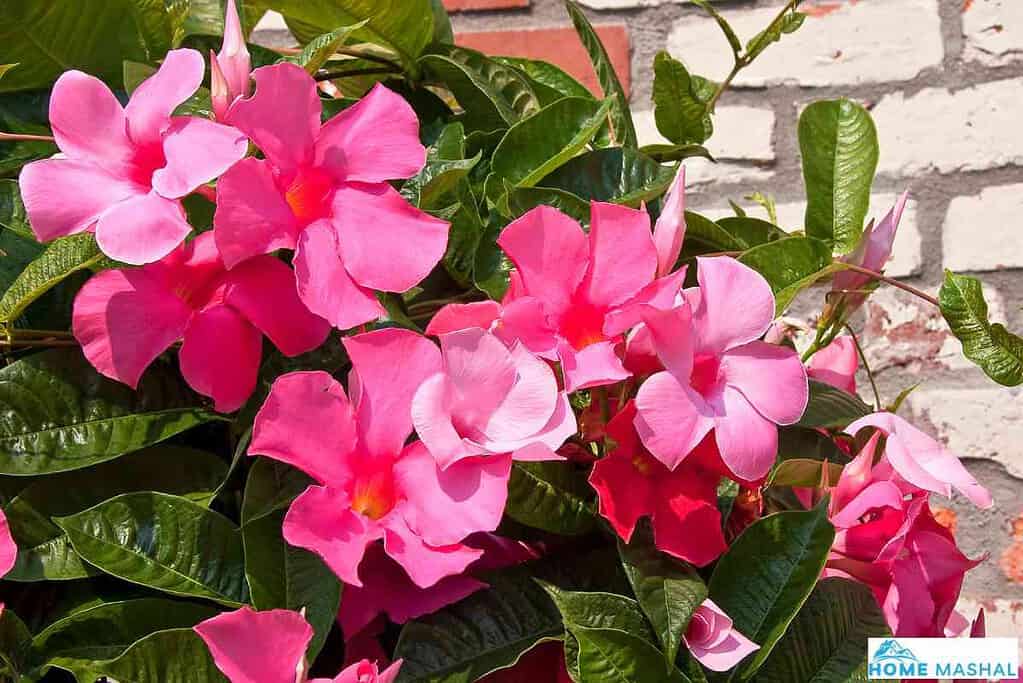
- Type of Plant: Perennial vine (often grown as an annual in colder climates)
- Geographic Origin: Central and South America
- Plant Size: 10 to 20 feet tall
- Sun Exposure: Full sun to partial shade
- Plant Zone: 9-11 (can be grown as an annual elsewhere)
Mandevilla is celebrated for its large, trumpet-shaped flowers that come in shades of pink, red, and white. These vines are perfect for adding a tropical feel to your garden. They prefer well-drained soil and regular watering, especially during dry periods.
Mandevilla vines can be grown in containers, making them ideal for patios and balconies. They are also excellent for training up trellises, pergolas, or fences. In cooler climates, they can be brought indoors to overwinter or grown as annuals.
3. Black-Eyed Susan Vine (Thunbergia alata)
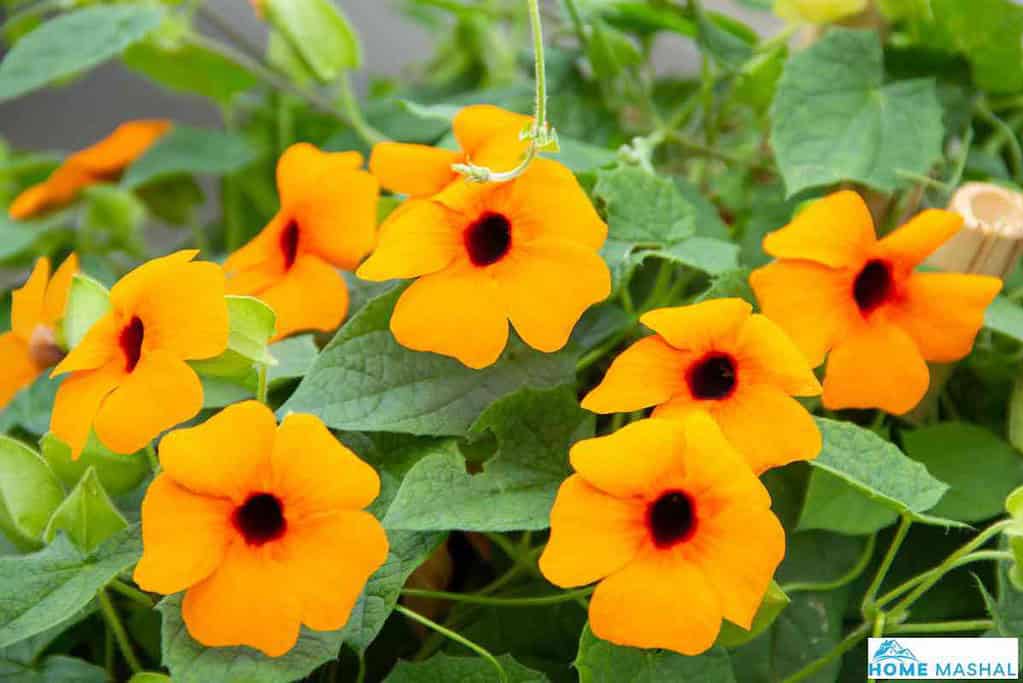
- Type of Plant: Annual vine
- Geographic Origin: Eastern Africa
- Plant Size: 3 to 8 feet tall
- Sun Exposure: Full sun to partial shade
- Plant Zone: 10-11 (grown as an annual elsewhere)
The Black-Eyed Susan Vine is known for its cheerful, bright yellow or orange flowers with a distinctive dark center. This fast-growing vine is perfect for adding quick color to your garden. It thrives in well-drained soil and requires regular watering.
Black-Eyed Susan Vines are ideal for hanging baskets, window boxes, or training up trellises and fences. They attract pollinators such as butterflies and bees, making them a great addition to any garden focused on supporting local wildlife.
4. Morning Glory (Ipomoea spp.)
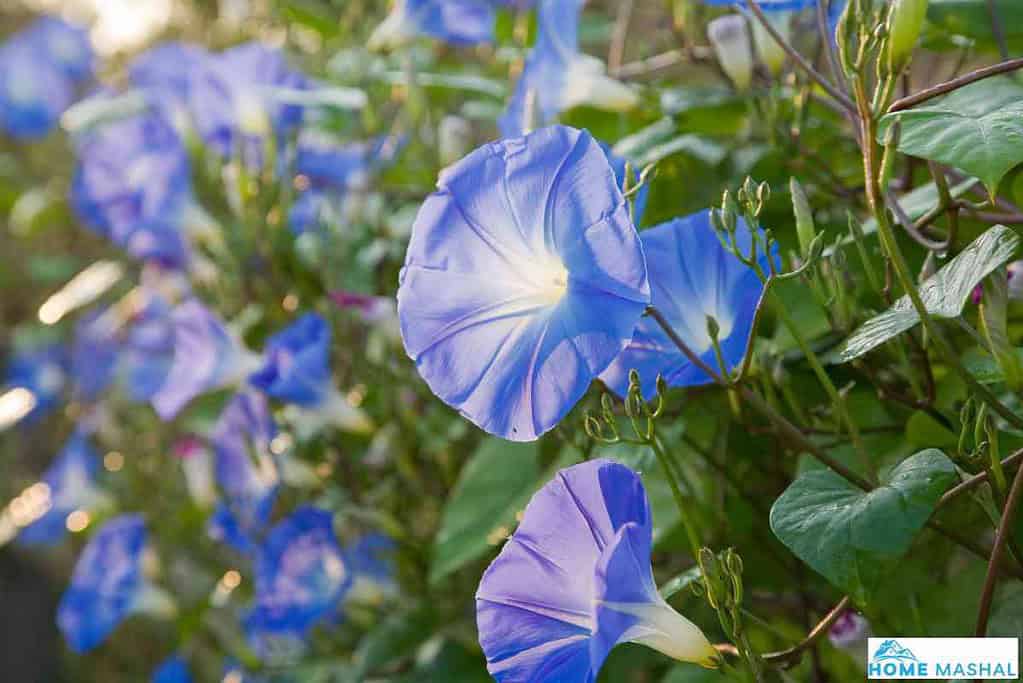
- Type of Plant: Annual vine
- Geographic Origin: Tropical and subtropical regions worldwide
- Plant Size: 6 to 10 feet tall
- Sun Exposure: Full sun
- Plant Zone: 2-11 (grown as an annual in colder zones)
Morning Glory vines are known for their vibrant, trumpet-shaped flowers that open in the morning and close by afternoon. They come in a variety of colors including blue, purple, pink, and white.
These vines are easy to grow and can quickly cover fences, trellises, and arbors. They prefer well-drained soil and require minimal care once established.
Morning Glories are also known for their heart-shaped leaves, which add to their ornamental appeal. They are excellent for creating a lush, colorful backdrop in your garden.
5. Trumpet Vine (Campsis radicans)
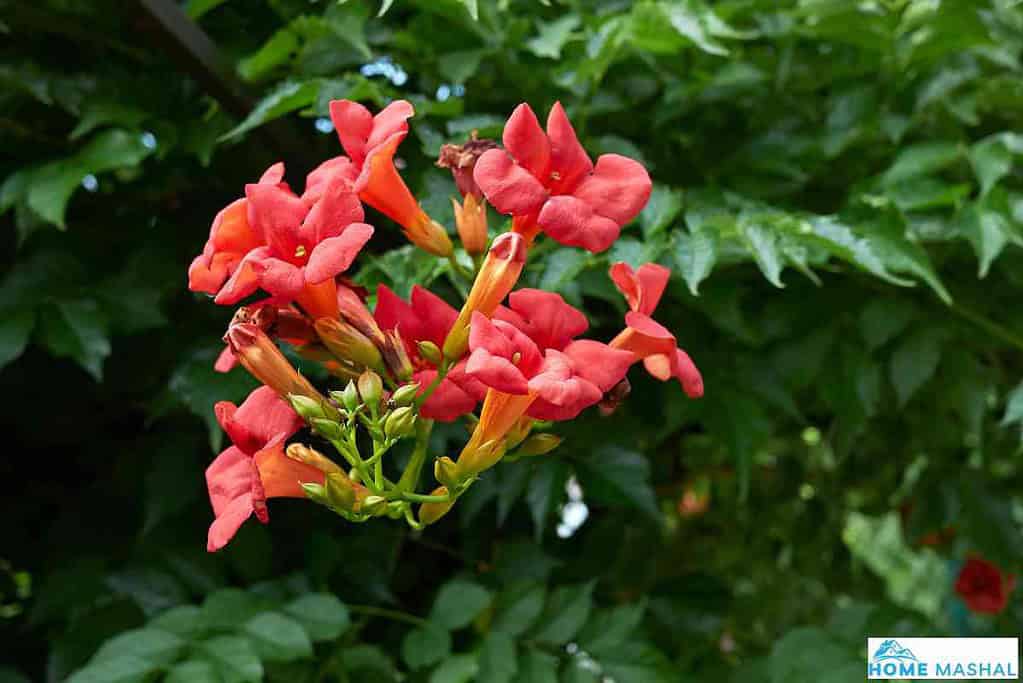
- Type of Plant: Perennial vine
- Geographic Origin: Southeastern United States
- Plant Size: 30 to 40 feet tall
- Sun Exposure: Full sun to partial shade
- Plant Zone: 4-9
Trumpet Vine is a vigorous climber known for its large, trumpet-shaped orange or red flowers that attract hummingbirds.
This vine can grow rapidly and is ideal for covering large structures such as fences, arbors, or pergolas. It prefers well-drained soil and can tolerate a range of soil conditions.
Trumpet Vine requires regular pruning to keep it in check and prevent it from becoming invasive. Its lush foliage and striking flowers make it a standout addition to any garden, providing a tropical feel and vibrant color throughout the summer.
6. Sweet Pea (Lathyrus odoratus)
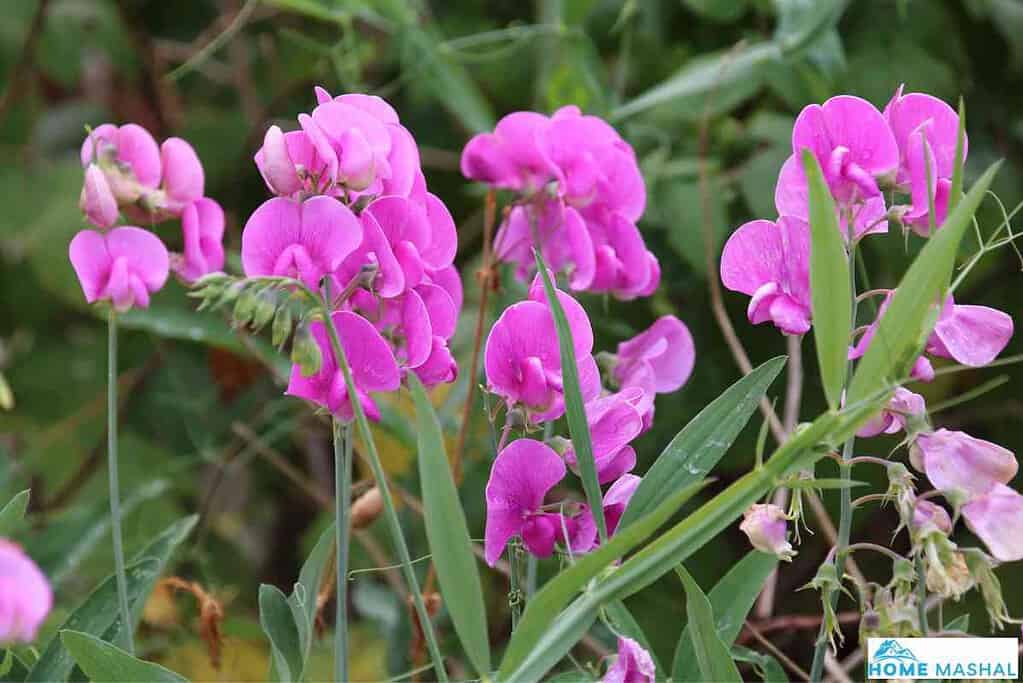
- Type of Plant: Annual vine
- Geographic Origin: Mediterranean region
- Plant Size: 6 to 8 feet tall
- Sun Exposure: Full sun
- Plant Zone: 2-11 (grown as an annual in colder zones)
Sweet Pea vines are cherished for their fragrant, delicate flowers that come in a wide range of colors including pink, purple, white, and red. These vines are perfect for adding a touch of romance to your garden.
They prefer well-drained, fertile soil and regular watering. Sweet Peas are ideal for growing on trellises, fences, or in containers.
They are also excellent for cut flowers, bringing their lovely scent indoors. To encourage continuous blooming, it’s important to deadhead spent flowers regularly.
See Also: 21 Cold-Tolerant Perennial Vines
7. Passionflower (Passiflora spp.)
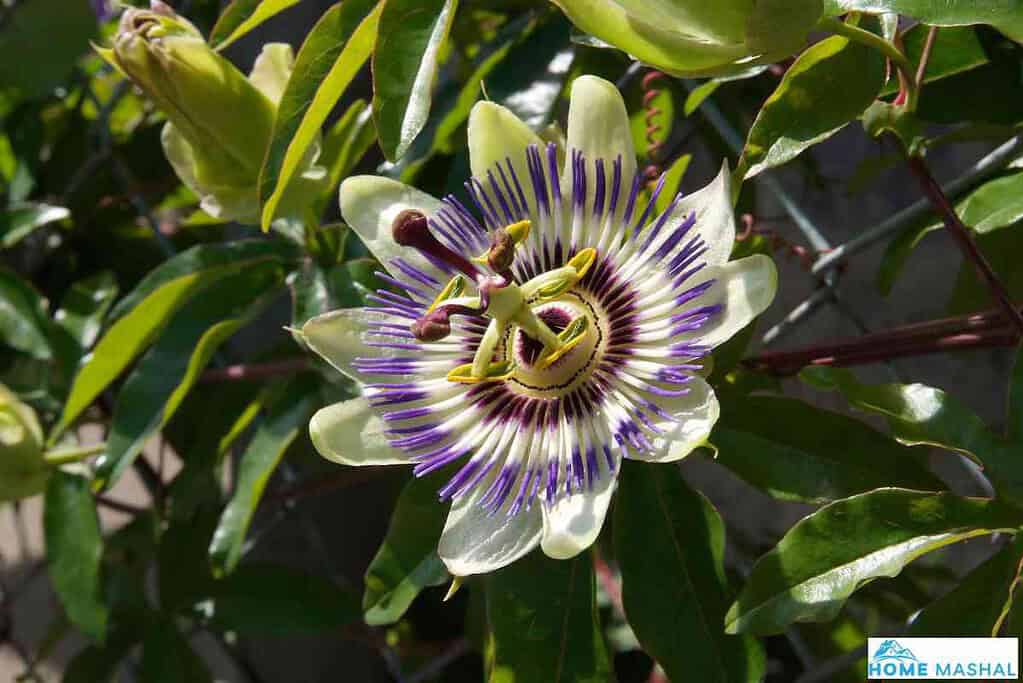
- Type of Plant: Perennial vine
- Geographic Origin: Tropical and subtropical regions of the Americas
- Plant Size: 10 to 30 feet tall
- Sun Exposure: Full sun to partial shade
- Plant Zone: 6-10
Passionflower vines are known for their exotic, intricate flowers that come in a variety of colors including purple, blue, white, and red. These vines are not only ornamental but also attract pollinators such as butterflies and bees.
They thrive in well-drained soil and require regular watering. Passionflower vines can be trained to climb trellises, arbors, or fences, adding a tropical feel to your garden. Some species also produce edible fruits, adding an extra dimension to their appeal.
8. Bougainvillea (Bougainvillea spp.)
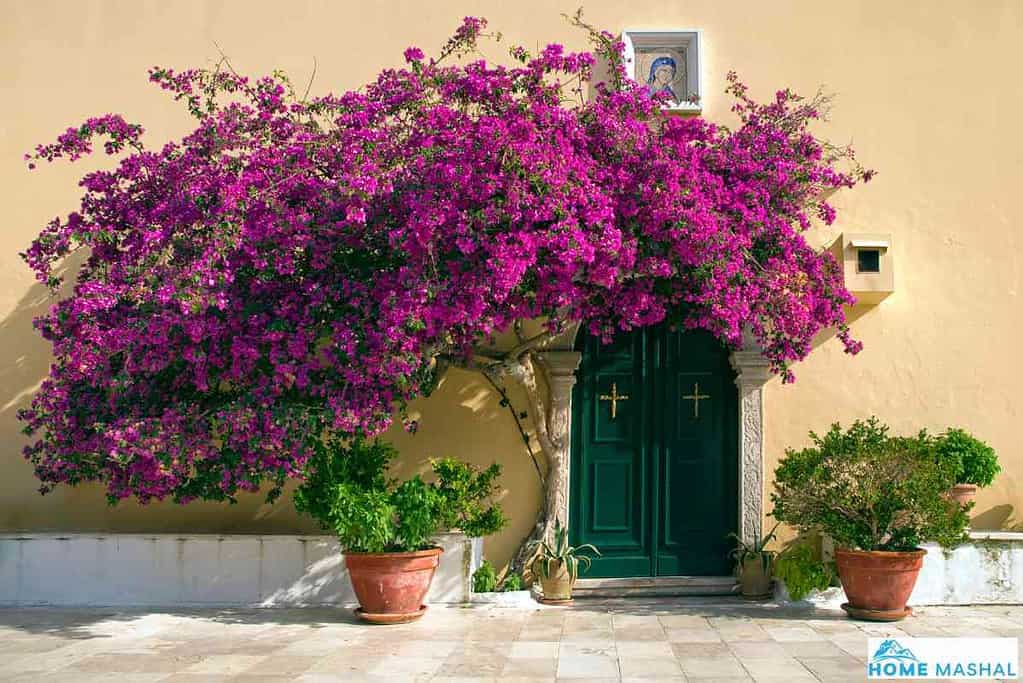
- Type of Plant: Perennial vine (often grown as an annual in colder climates)
- Geographic Origin: South America
- Plant Size: 15 to 30 feet tall
- Sun Exposure: Full sun
- Plant Zone: 9-11 (can be grown as an annual elsewhere)
Bougainvillea is a striking vine known for its vibrant bracts that come in shades of pink, purple, red, orange, and white. These bracts surround the small, inconspicuous flowers, creating a stunning display of color.
Bougainvillea thrives in well-drained soil and requires minimal watering once established. It is perfect for growing on trellises, walls, or in containers. In cooler climates, it can be brought indoors to overwinter.
Bougainvillea is also known for its thorny stems, which can provide added security when grown along fences or walls.
9. Honeysuckle (Lonicera spp.)

- Type of Plant: Perennial vine
- Geographic Origin: Northern Hemisphere
- Plant Size: 10 to 20 feet tall
- Sun Exposure: Full sun to partial shade
- Plant Zone: 4-9
Honeysuckle vines are beloved for their sweetly fragrant flowers, which can be tubular or trumpet-shaped and come in colors like yellow, white, pink, and red. These flowers attract hummingbirds and butterflies, making Honeysuckle a great choice for wildlife gardens.
The vines are hardy and adaptable, thriving in a variety of soil types as long as they are well-drained. Honeysuckle can be trained to climb trellises, fences, and arbors, or allowed to sprawl as a ground cover.
Regular pruning helps maintain their shape and encourages more blooms throughout the summer.
10. Moonflower (Ipomoea alba)
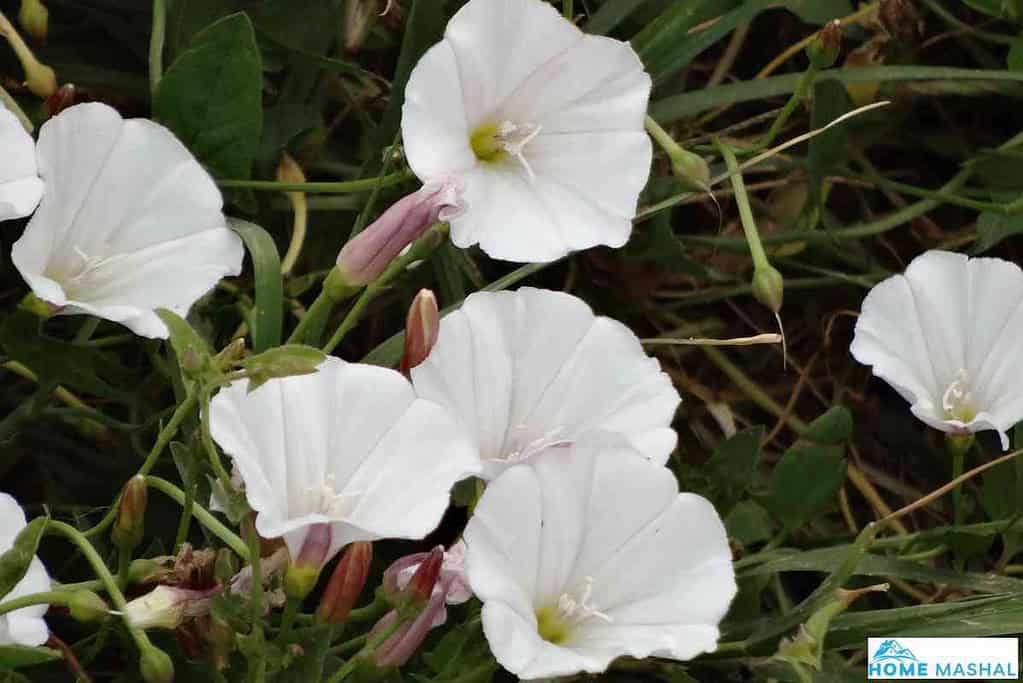
- Type of Plant: Annual vine
- Geographic Origin: Tropical and subtropical regions of the Americas
- Plant Size: 10 to 15 feet tall
- Sun Exposure: Full sun to partial shade
- Plant Zone: 10-12 (grown as an annual elsewhere)
Moonflower vines are known for their large, fragrant, white flowers that open in the evening and close by morning. These night-blooming flowers add a magical touch to any garden and are perfect for moonlit evenings.
Moonflowers thrive in well-drained soil and require regular watering. They are ideal for growing on trellises, fences, or arbors, where their climbing habit can be showcased.
The heart-shaped leaves add additional ornamental value. Moonflowers are also excellent for attracting nighttime pollinators like moths.
11. Jasmine (Jasminum spp.)
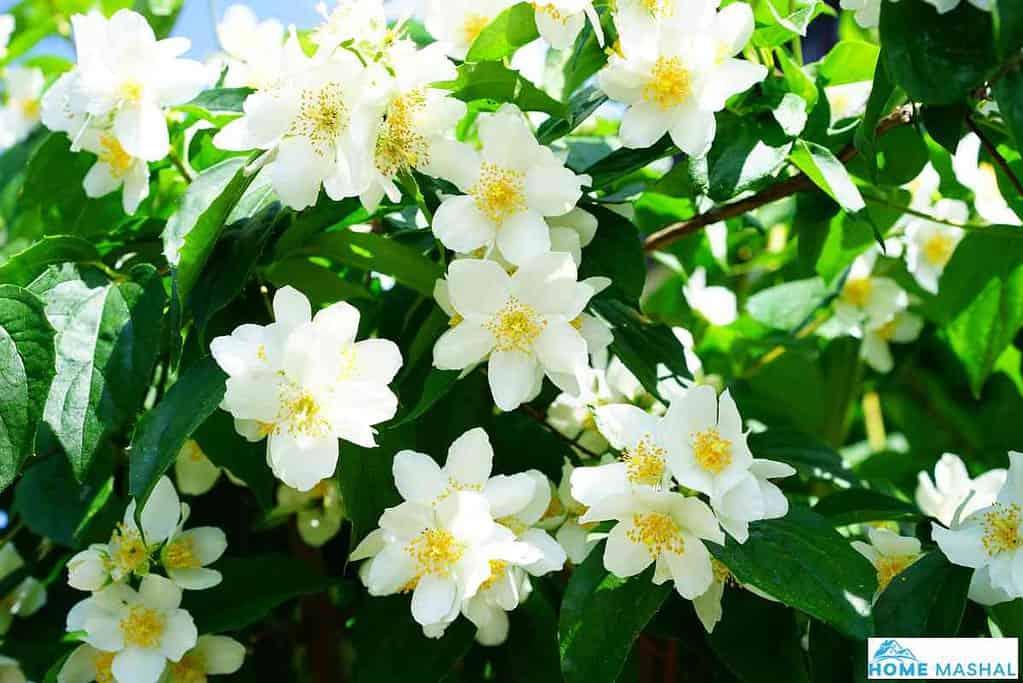
- Type of Plant: Perennial vine
- Geographic Origin: Tropical and subtropical regions of Asia, Africa, and Europe
- Plant Size: 10 to 15 feet tall
- Sun Exposure: Full sun to partial shade
- Plant Zone: 7-10
Jasmine vines are celebrated for their intensely fragrant, star-shaped flowers, which can be white, yellow, or pink. These flowers are often used in perfumes and teas. Jasmine prefers well-drained soil and regular watering.
It can be trained to climb trellises, fences, or arbors, or grown in containers. Jasmine is also a popular choice for indoor gardens, where its fragrance can be enjoyed year-round. Regular pruning helps maintain its shape and encourages more blooms.
12. Climbing Roses (Rosa spp.)
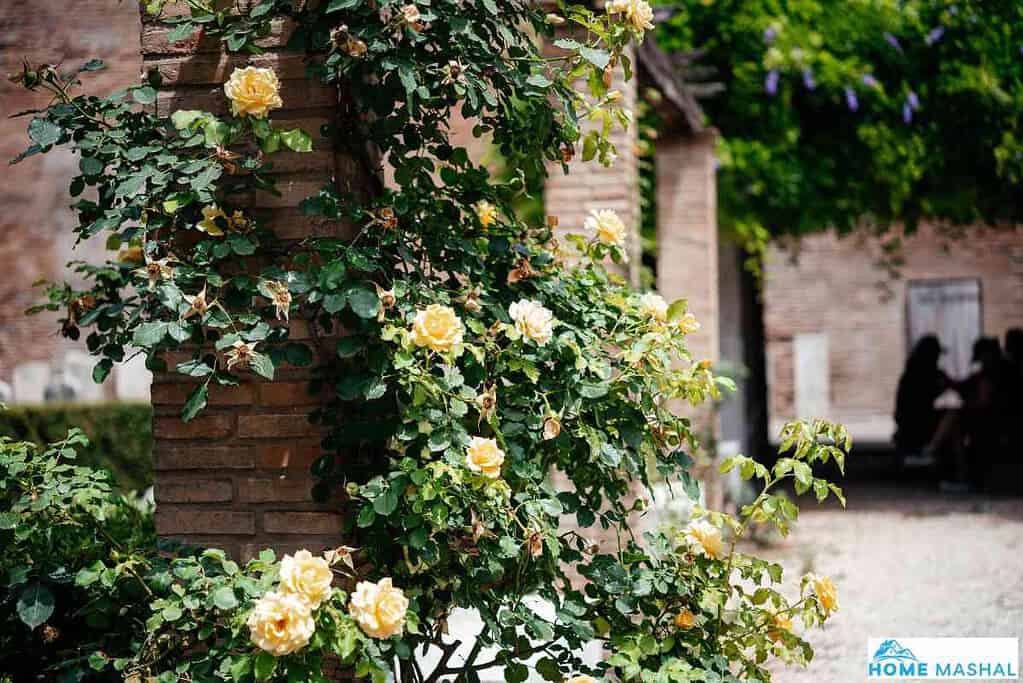
- Type of Plant: Perennial vine
- Geographic Origin: Various regions worldwide
- Plant Size: 8 to 20 feet tall
- Sun Exposure: Full sun
- Plant Zone: 4-9
Climbing Roses are known for their large, fragrant blooms that come in a wide range of colors including red, pink, yellow, white, and orange. These vines are perfect for adding a touch of elegance to your garden.
They prefer well-drained, fertile soil and regular watering. Climbing Roses can be trained to grow on trellises, arbors, or fences, creating a stunning vertical display. They require regular pruning to maintain their shape and encourage continuous blooming.
Climbing Roses are also excellent for cut flowers, bringing their beauty and fragrance indoors.
13. Coral Vine (Antigonon leptopus)
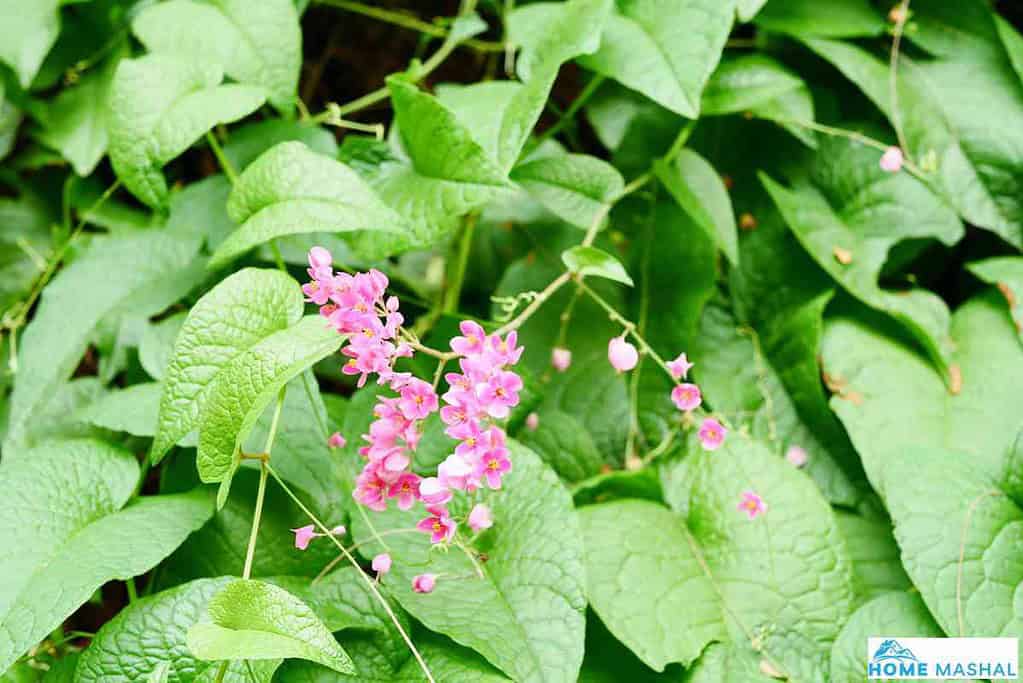
- Type of Plant: Perennial vine
- Geographic Origin: Mexico
- Plant Size: 20 to 30 feet tall
- Sun Exposure: Full sun to partial shade
- Plant Zone: 8-11
Coral Vine, also known as Queen’s Wreath, is known for its clusters of small, pink or white flowers that resemble coral. These flowers attract pollinators such as bees and butterflies. Coral Vine thrives in well-drained soil and requires minimal watering once established.
It is perfect for covering fences, trellises, or arbors, adding a touch of tropical beauty to your garden. This vine can grow rapidly, so regular pruning is necessary to keep it in check. Its heart-shaped leaves add to its ornamental appeal.
14. Cypress Vine (Ipomoea quamoclit)

- Type of Plant: Annual vine
- Geographic Origin: Tropical regions of the Americas
- Plant Size: 10 to 20 feet tall
- Sun Exposure: Full sun
- Plant Zone: 10-11 (grown as an annual elsewhere)
Cypress Vine is known for its delicate, fern-like foliage and small, star-shaped flowers that come in red, pink, or white. These flowers attract hummingbirds and butterflies, making Cypress Vine a great choice for wildlife gardens.
The vine prefers well-drained soil and regular watering. Cypress Vine is ideal for growing on trellises, fences, or in containers. Its fast growth and delicate appearance make it a charming addition to any garden, providing a splash of color and texture throughout the summer.
15. Hyacinth Bean (Lablab purpureus)
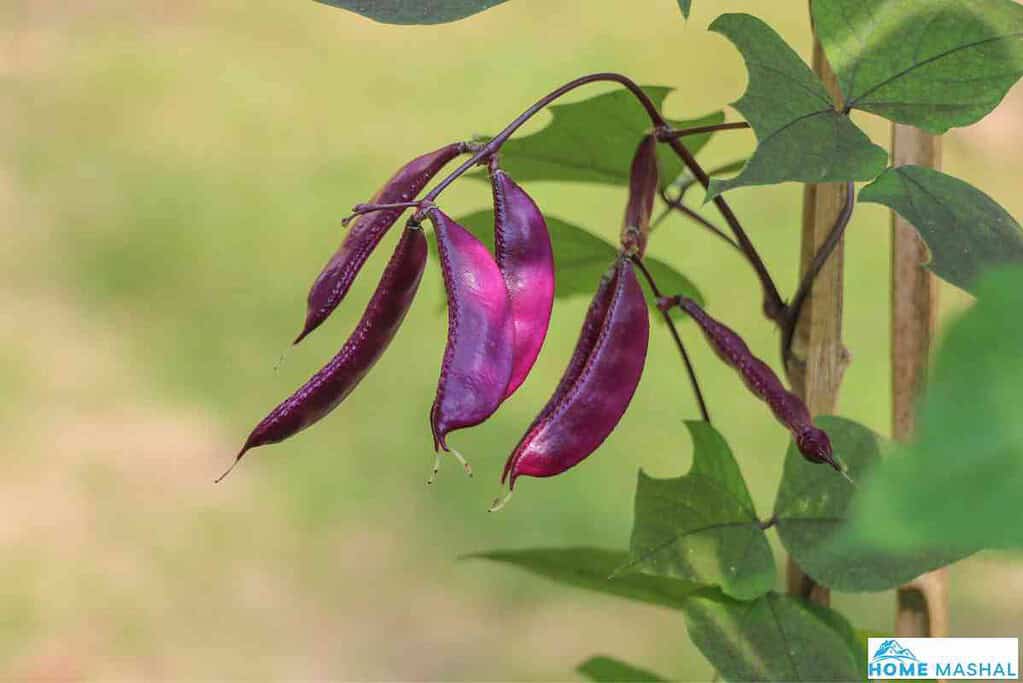
- Type of Plant: Annual vine
- Geographic Origin: Africa
- Plant Size: 10 to 15 feet tall
- Sun Exposure: Full sun
- Plant Zone: 9-11 (grown as an annual elsewhere)
Hyacinth Bean is a striking vine known for its purple flowers and glossy, purple-tinged leaves. The vine also produces edible beans, adding an extra dimension to its appeal. Hyacinth Bean thrives in well-drained soil and requires regular watering.
It is perfect for growing on trellises, fences, or arbors, where its vibrant colors can be showcased. The vine is also excellent for attracting pollinators such as bees and butterflies. Regular harvesting of the beans encourages more blooms and maintains the plant’s vigor.
16. Cardinal Climber (Ipomoea × multifida)
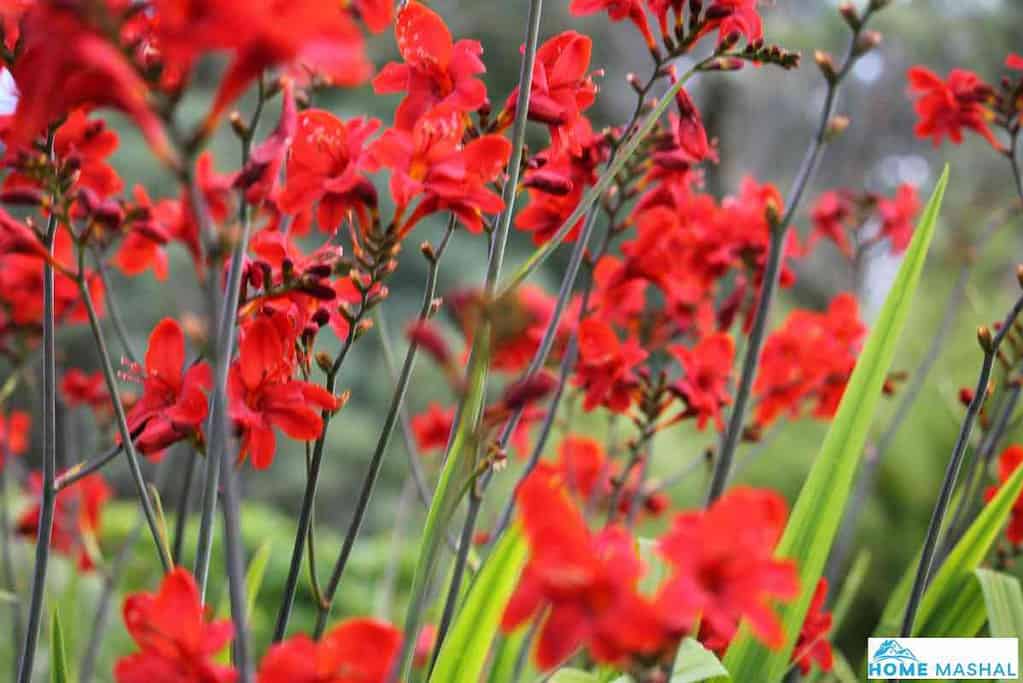
- Type of Plant: Annual vine
- Geographic Origin: Hybrid of species from the Americas
- Plant Size: 10 to 20 feet tall
- Sun Exposure: Full sun
- Plant Zone: 10-11 (grown as an annual elsewhere)
Cardinal Climber is known for its bright red, tubular flowers that attract hummingbirds. The vine’s delicate, fern-like foliage adds to its ornamental appeal. Cardinal Climber thrives in well-drained soil and requires regular watering.
It is ideal for growing on trellises, fences, or arbors, where its vibrant flowers can be showcased. The vine’s rapid growth and striking appearance make it a popular choice for adding a splash of color to any garden.
Regular deadheading encourages continuous blooming throughout the summer.
17. Butterfly Pea (Clitoria ternatea)
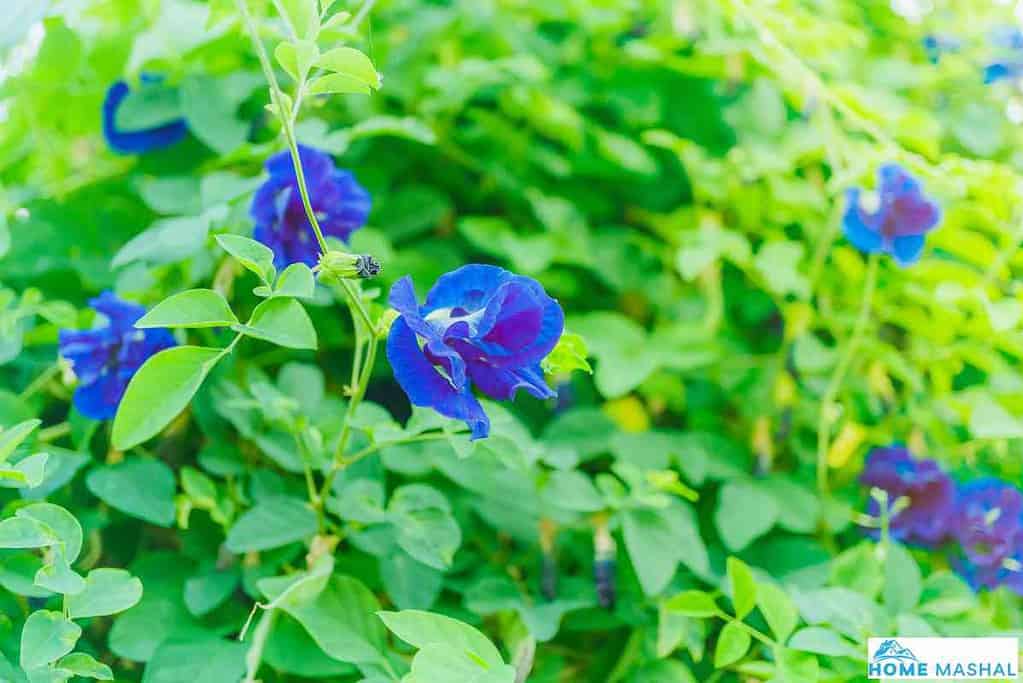
- Type of Plant: Perennial vine (often grown as an annual in colder climates)
- Geographic Origin: Tropical Asia
- Plant Size: 10 to 15 feet tall
- Sun Exposure: Full sun to partial shade
- Plant Zone: 10-11 (can be grown as an annual elsewhere)
Butterfly Pea is celebrated for its striking, deep blue flowers, which sometimes have a white center. These flowers are not only beautiful but also edible and often used to make herbal tea that changes color with pH.
The vine prefers well-drained soil and regular watering. Butterfly Pea is ideal for growing on trellises, fences, or in containers. Its vibrant flowers attract pollinators such as bees and butterflies, adding life to your garden.
In addition to its ornamental value, Butterfly Pea is also used in traditional medicine and as a natural dye.
18. Canary Creeper (Tropaeolum peregrinum)
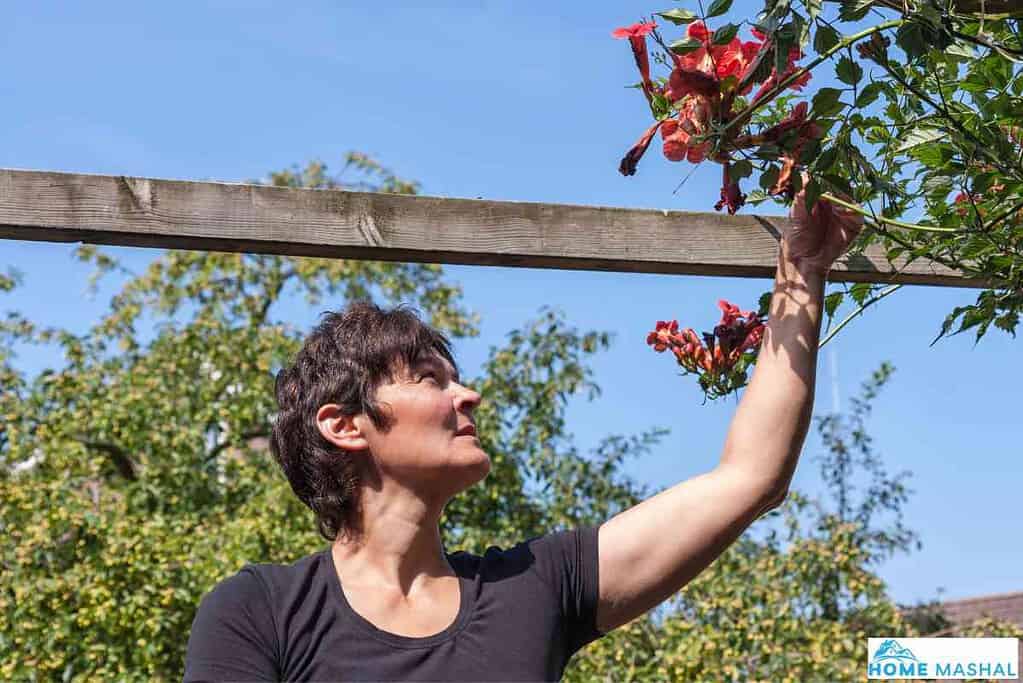
- Type of Plant: Annual vine
- Geographic Origin: South America
- Plant Size: 8 to 12 feet tall
- Sun Exposure: Full sun to partial shade
- Plant Zone: 9-11 (grown as an annual elsewhere)
Canary Creeper is known for its bright yellow, fringed flowers that resemble canary birds in flight. The vine’s delicate, lobed leaves add to its ornamental appeal. Canary Creeper thrives in well-drained soil and requires regular watering.
It is perfect for growing on trellises, fences, or in containers, where its cheerful flowers can be showcased. This vine is also excellent for attracting pollinators such as bees and butterflies.
Its rapid growth and unique flowers make it a charming addition to any garden, providing a splash of color throughout the summer.
19. Blue Sky Vine (Thunbergia grandiflora)
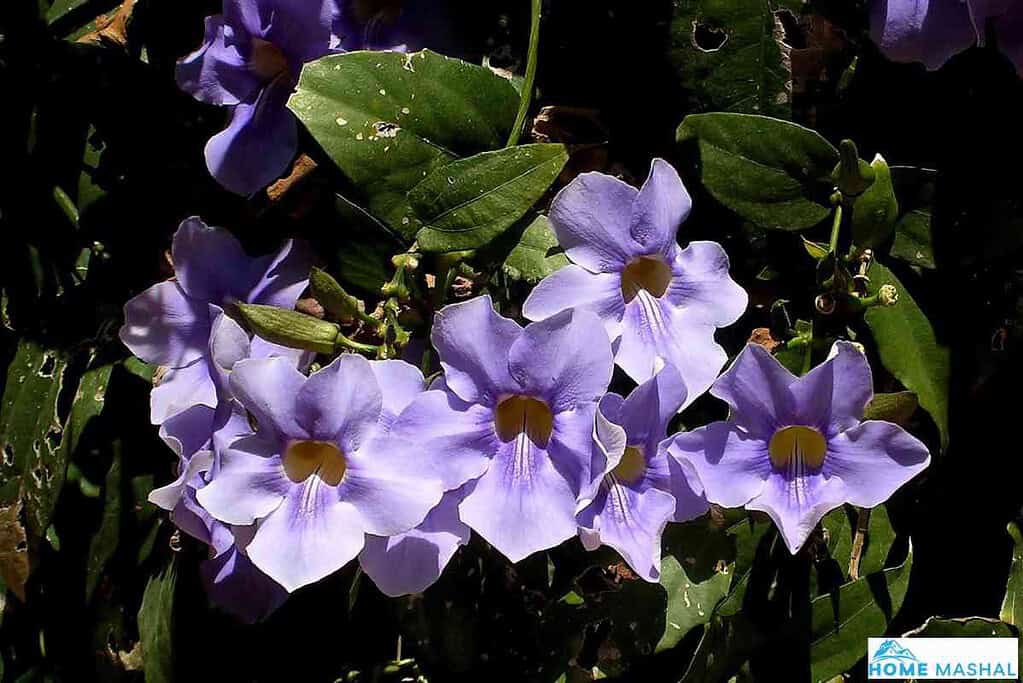
- Type of Plant: Perennial vine
- Geographic Origin: India
- Plant Size: 20 to 30 feet tall
- Sun Exposure: Full sun to partial shade
- Plant Zone: 9-11
Blue Sky Vine is known for its large, trumpet-shaped blue or lavender flowers with a yellow throat. These stunning flowers attract pollinators such as bees and butterflies. The vine prefers well-drained soil and regular watering.
Blue Sky Vine is ideal for growing on trellises, fences, or arbors, where its vibrant flowers can be showcased. Its lush, green foliage adds to its ornamental appeal.
Blue Sky Vine can grow rapidly, so regular pruning is necessary to keep it in check and encourage continuous blooming.
20. Purple Bell Vine (Rhodochiton atrosanguineus)
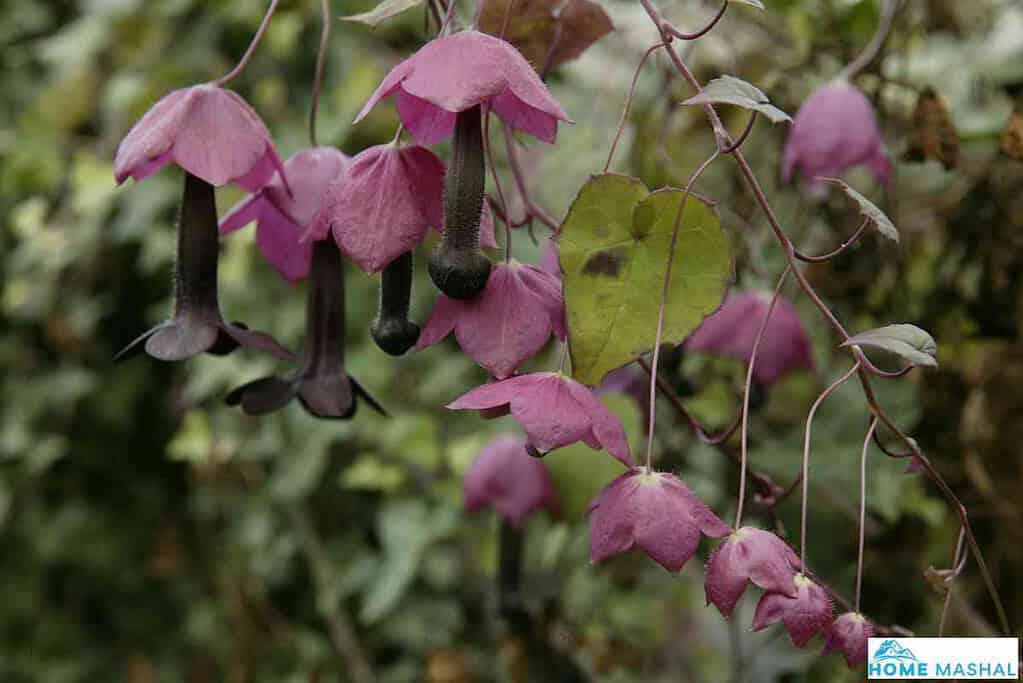
- Type of Plant: Annual vine
- Geographic Origin: Mexico
- Plant Size: 8 to 10 feet tall
- Sun Exposure: Full sun to partial shade
- Plant Zone: 9-11 (grown as an annual elsewhere)
Purple Bell Vine is known for its unique, bell-shaped purple flowers that dangle from the vine, creating a striking display. The vine’s heart-shaped leaves add to its ornamental appeal. Purple Bell Vine thrives in well-drained soil and requires regular watering.
It is perfect for growing on trellises, fences, or in containers, where its unique flowers can be showcased. This vine is also excellent for attracting pollinators such as bees and butterflies.
Its rapid growth and distinctive flowers make it a standout addition to any garden, providing a touch of exotic beauty throughout the summer.
See Also: 32 Perennial Flowers That Bloom From Spring To Fall
21. Cross Vine (Bignonia capreolata)
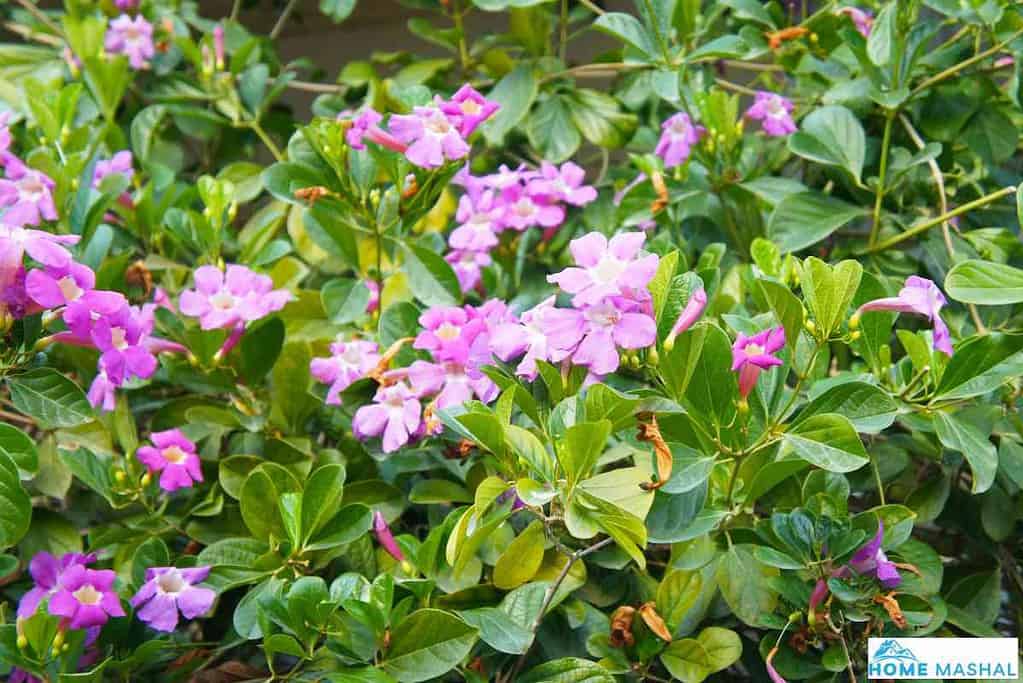
- Type of Plant: Perennial vine
- Geographic Origin: Southeastern United States
- Plant Size: 30 to 50 feet tall
- Sun Exposure: Full sun to partial shade
- Plant Zone: 6-9
Cross Vine is known for its trumpet-shaped flowers that come in shades of red, orange, and yellow. These flowers attract hummingbirds and butterflies, making Cross Vine a great choice for wildlife gardens.
The vine prefers well-drained soil and regular watering. Cross Vine is ideal for growing on trellises, fences, or arbors, where its vibrant flowers can be showcased. Its evergreen foliage adds to its ornamental appeal, providing year-round interest.
Cross Vine can grow rapidly, so regular pruning is necessary to maintain its shape and encourage continuous blooming throughout the summer.
22. Bleeding Heart Vine (Clerodendrum thomsoniae)

The bleeding heart vine is a bushy and clustering plant with a striking appearance.
The outer part of the flower is creamy white bell-shaped calyxes, while a vibrant red star-shaped flower peeks through the bottom.
However, these vines will need water-soluble fertilizer throughout the growing season to produce more flowers.
They are best grown under a shade pergola or in a tree-dappled side yard in zones 10 to 12.
23. Orange Clockvine (Thunbergia gregorii)

The orange clock vine is another flowering vine that can help retain your garden’s curb appeal all summer.
They are best grown to cover a trellis for a single season, as they put up a show with their long-blooming orange flowers.
Orange clock vines are Native to tropical regions of Africa, primarily found in zones 9 to 10.
They also appreciate mild climates and will reward you with more sporadic bloom year-round when planted in these regions.
They demand full sun and moderate water. And when mature, the Orange clock vine could be 8 to 10 feet tall.
Aside from that, these showy vines are easy to grow and maintain.
24. Tall Morning Glory (Ipomoea purpurea)

You can call it tall morning glory or common morning glory. They aren’t the most flowering vines since their leaves steal the show.
Tall Morning Glory has more leaves than their velvety trumpet-shaped flowers that only bloom from June to October. They also attract good pollinators like hummingbirds, butterflies, and more.
The best part is this vine only needs little attention. Just water moderately and that it has access to full sun.
But I must warn you; they are poisonous when ingested. So plant them with caution.
25. Wisteria (Wisteria frutescens)

Many gardeners gushed Wisteria to be a complicated beauty.
They will also grace your landscape with bountiful cascading purple, pink, white, or blue blooms that appeal to the eyes.
Wisteria also detonates such an inviting fragrance to the air. Unfortunately, they constantly need fertile and should be planted in well-drained soil.
Aside from that, Wisterias are vigorous climbers and can reach over 10m (33ft) in height and width.
And since they are hardy and quite heavy, most gardeners prefer to support them with structures.
Wisterias requires full sun. Hence, it is best to plant them on a south- or west-facing wall or pergola. It also takes time to grow and bloom. But it is worth the wait, though.
What Is The Easiest Vine To Grow?
Some vines are pain-free to plant and maintain, yet they reward you with dramatic flowers.
Here are a few:
- Clematis
- American Wisteria
- Bougainvillea
- Butterfly Vine
- Honeysuckle
- Scarlet Runner Beans
- Climbing Hydrangea
- Star Jasmine
- Nasturtiums
- Climbing Roses
What Is The Fastest Flowering Vine?
Vines are typically fast-going parts. However, some species have accelerating growth genes. For instance, Akebia quinata is one of these fastest-growing flowering vines.
It adds about 20 feet to its height every year. When grown in zone 6 or above (where they thrive the most), they become evergreen and a permanent addition to your garden.
Other vines that fall into this category are:
- Morning Glory (Ipomoea Indica)
- Passion Flower (Passiflora spp.)
- Dipladenia (Mandevilla Boliviensis)
- Sweet Pea (Lathyrus Odoratus)
- Clematis (Clematis Spp.)
- Japanese Knotweed (Fallopia Japonica)
- Rambling Rose (Rosa spp.)
- Nasturtium (Tropaeolum Major)
- Honeysuckle (Lonicera spp.)
- Potato Vine (Solanum Laxum ‘Album’)
- Trumpet Vine (Campsis Radicans)
- Everlasting Pea (Lathyrus Latifolius)
- Star Jasmine (Travhelospermum Jasminoides)
- Swamp Leather Flower (Clematis Crispa)
- Chocolate Vine (Akebia Quinata)
What Is The Most Common Vine Plant?
Everyone knows the heartleaf philodendron (Philodendron hederaceum) to be arguably one of the most common vining houseplants.
Well, there are plenty of them. The reason they are so popular is because they are fast-growing, low-maintenance, and it looks great in nearly every space.
They are versatile as well. You can use them in hanging baskets, on shelves, bookcases, working spaces, and whatnot.
You can choose from this list:
- Pothos (Epipremnum aureum)
- Brasil Philodendron (Philodendron hederaceum ‘Brasil’)
- Philodendron Micans
- Mini Monstera (Raphidophora tetrasperma)
- Satin Pothos (Scindapsus pictus ‘Exotica’)
- Scindapsus pictus ‘Argyraeus’
- Scindapsus Treubii ‘Moonlight’
- Monstera deliciosa
- Swiss Cheese Plant (Monstera adansonii)
- Monstera Peru (Monstera karstenianum)
- String of Pearls (Senecio rowleyanus)
- String of Hearts (Ceropegia woodii)
- String of Dolphins (Senecio peregrinus)
- String of Bananas (Senecio radicans)
- String of Turtles (Peperomia prostrata)
- Hoya Carnosa
- Hoya Compacta (Hoya carnosa ‘Compacta’)
- Arrowhead Plant (Syngonium podophyllum)
- Spiderwort (Tradescantia)
- String of Nickels (Dischidia nummularia)
- English Ivy (Hedera helix)
Mind you, some of these vines are toxic to pets and humans.
What Stops Vines From Growing?
If you ever had to deal with any of these vines that are overly stubborn or persistent, here is what you should do:
You can use systemic herbicide to kill them vine —that is, if you want to eliminate them.
Strike the herbicide straight to the roots. It will destroy them for good!
Vinegar and boiling water is the most humane way to do this.
However, if you only want them tamed, you can see the invasive parts and their root system.
You can also smother them with mulch.
What Type Of Vines I Should Never Plant?
Here is a list of vines you should NEVER plant in or around your property if you cherish your home, environment, or pets.
- Bittersweets
- Wisteria
- English Ivy
- Sweet Autumn Clematis
- Ajuga
- Barberry
- Burning Bush
- Lantana
- Butterfly Bush
- Privet
- Norway Maple Tree
- Japanese Knotweed
- Kudzu
- Tansy
- Purple Loosestrife
- Japanese Honeysuckle
- Porcelain Berry
None of these vines are extremely poisonous that they could kill upon contact.
NO! But they are rampaging, monstrous vines that are invasive.
They spread aggressively and are very territorial. They will outcompete other surrounding plants and won’t hesitate to choke out and kill them (including the ones in your garden) if they ever cross paths.
Aside from that, they can overwhelm your structures and cause severe damage.
Conclusion
So that is all about the flowering vines that bloom all summer. Again, some of these vines are poisonous, regardless of their beauty.
If you plant such a variant, keep them out of your pet and children’s reach, as contact with these vines will trigger an itchy skin rash or worse.
Related:
